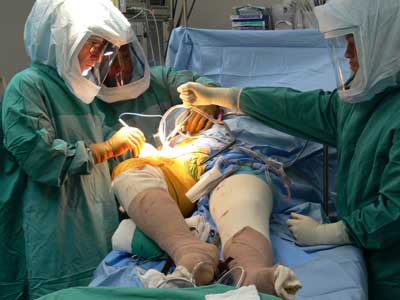Less Pain, Faster Recovery
Written by Mark J. Powers, MD, F.A.C.S., F.A.A.O.S.
There are many underlying causes of hip pain with the most common being arthritis. Careful clinical evaluation which consists of a history, physical exam and x–rays leads to a diagnosis of the correct pathology in most individuals. Occasionally further diagnostic testing (MRI, CT scan, bone scan, blood test) and repeated examination may be required.

The treatment rendered depends upon the diagnosis as well as the individual’s needs. The majority of hip complaints can be treated with conservative measures consisting of observation, medication, physical therapy, and occasional injections. However, if the disease has progressed to the extent that conservative modalities yield little benefit, surgical intervention may be warranted.
Hip arthritis progressively limits a person’s activities of daily living as well as quality of life. It is a major cause of disability world wide. The advent of modern total hip arthroplasty offers a patient a highly successful and reliable procedure that improves function and alleviates their pain. Approximately 200,000 total hip replacements are performed annually in the United States, and this incidence shall increase as the population ages.
Over the past 30 years, there have been significant technological and physiological advancements in the designs of total hip arthroplasties. Yet, in only the past few years have there been advances in the surgical approach of the hip.
Traditional surgical approaches to the hip demand muscular, ligamentous, and tendon detachment, requiring up to three months of protection for adequate healing. Minimally invasive techniques describe variations and refinements of the traditional approaches such as less detachment and small incisions. Initially they have the promise of reducing soft tissue trauma, pain and expedite recovery. Instead it was soon realized it created more soft tissue trauma and studies demonstrated a higher complication rate.
Lessons learned from this minimally invasive phase were not lost, and since 2005, I have been intricately involved in the development of a truly muscle sparing technique. The surgical approach is via the anterolateral or anterior aspect of the hip and requires NO muscle or tendon detachment, and the incision length varies between 8-12 cm (3-4 ½ inches). The result is immediate hip stability, a significant reduction in postoperative pain, and rapid functional recovery. The majority of patients require a shorter hospital stay, have minimal pain and are ambulating with a cane in 24 hours. Most are driving within 2 weeks and have limited postoperative physically therapy requirements.
The muscle sparing approach is a synergy of innovative implant design, instrumentation and surgical technique resulting in the potential patient benefits of improved range of mobility, preserved strength and function, superior cosmetic results, significant postoperative pain reduction, shortened hospital stay, and accelerated rehabilitation. View our video in the Muscle Sparing Video box to the right.
The physicians at Florida Orthopaedic Specialists are committed to providing the highest quality of medical care. If you are experiencing hip, knee, shoulder, foot/ankle, spine or sports medicine related pain or injury an orthopaedic physician can help determine a correct diagnosis and recommend appropriate treatment options. Call today to make an appointment!

